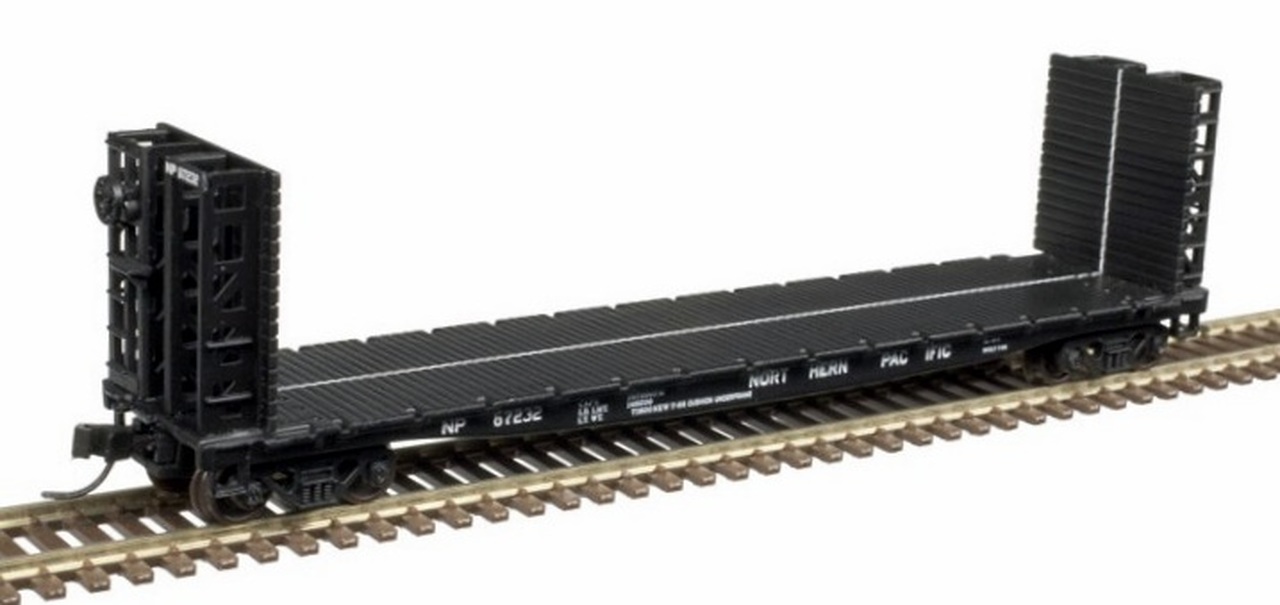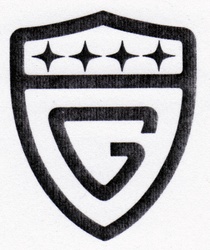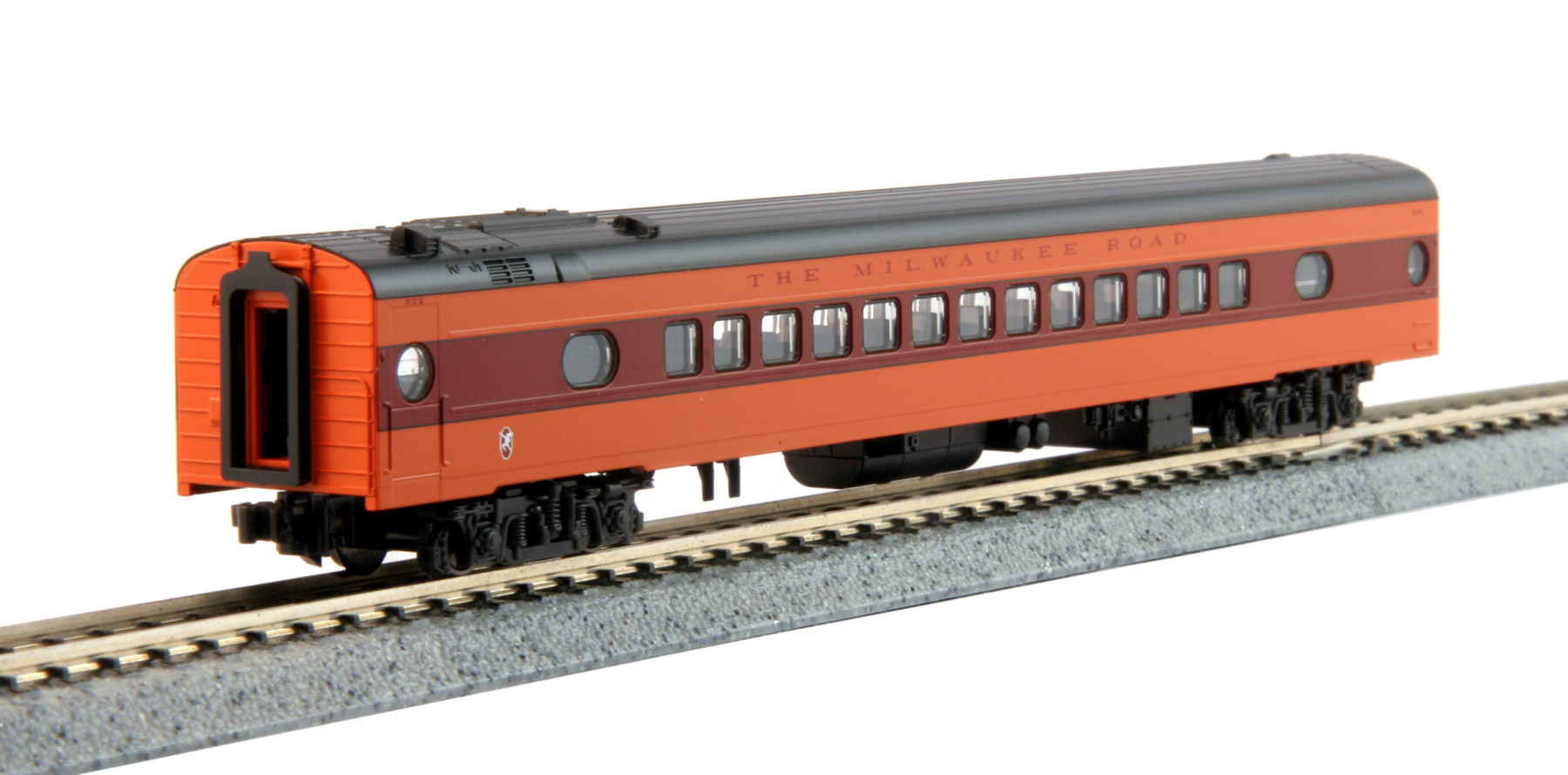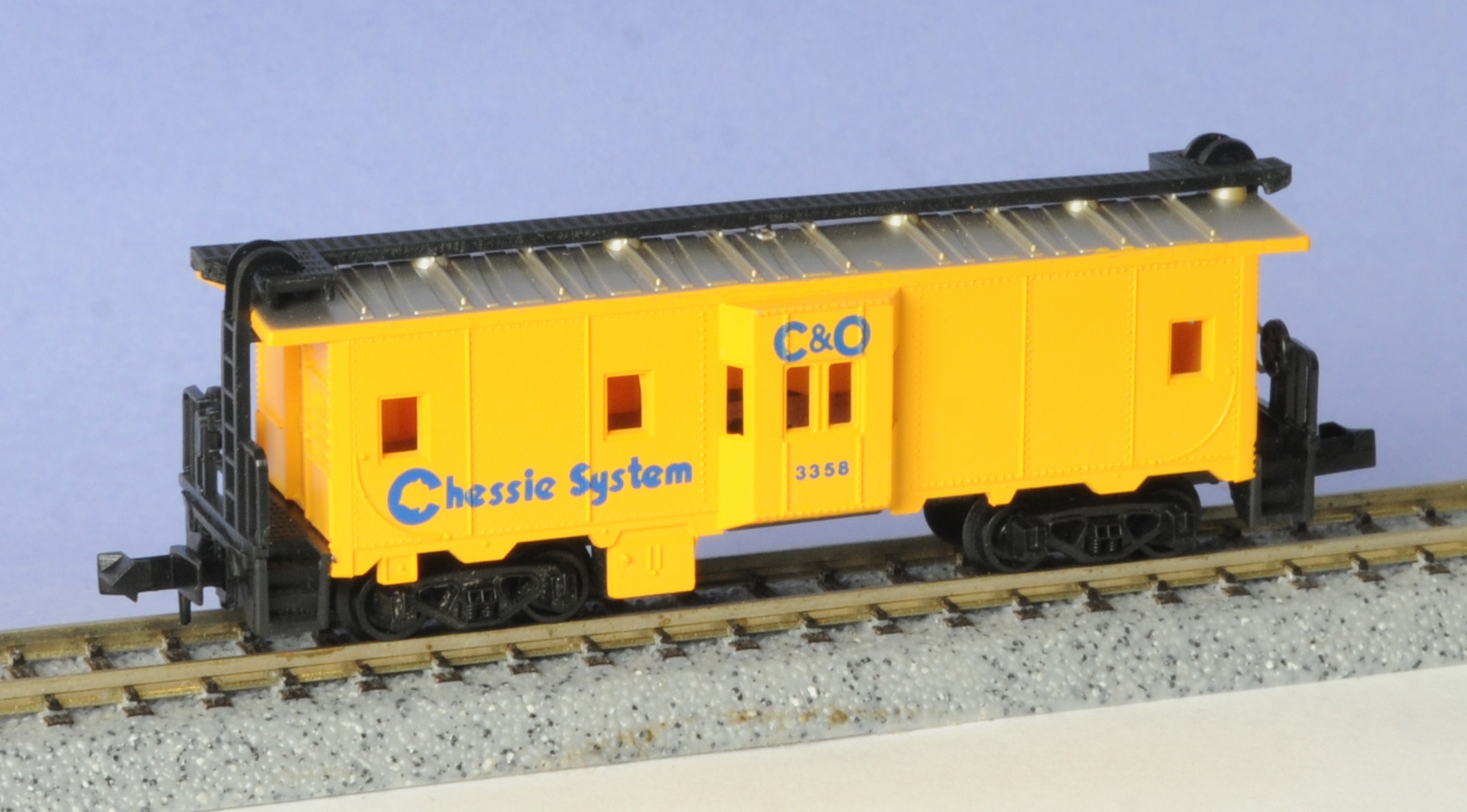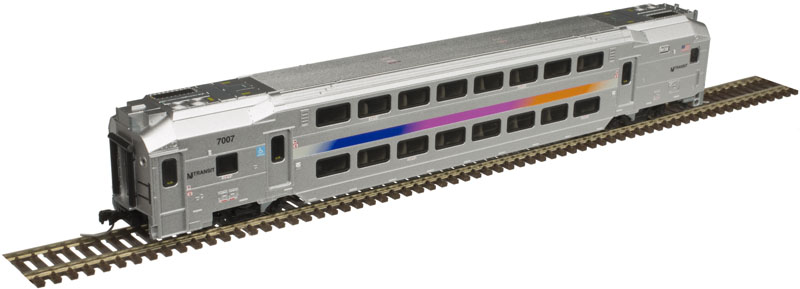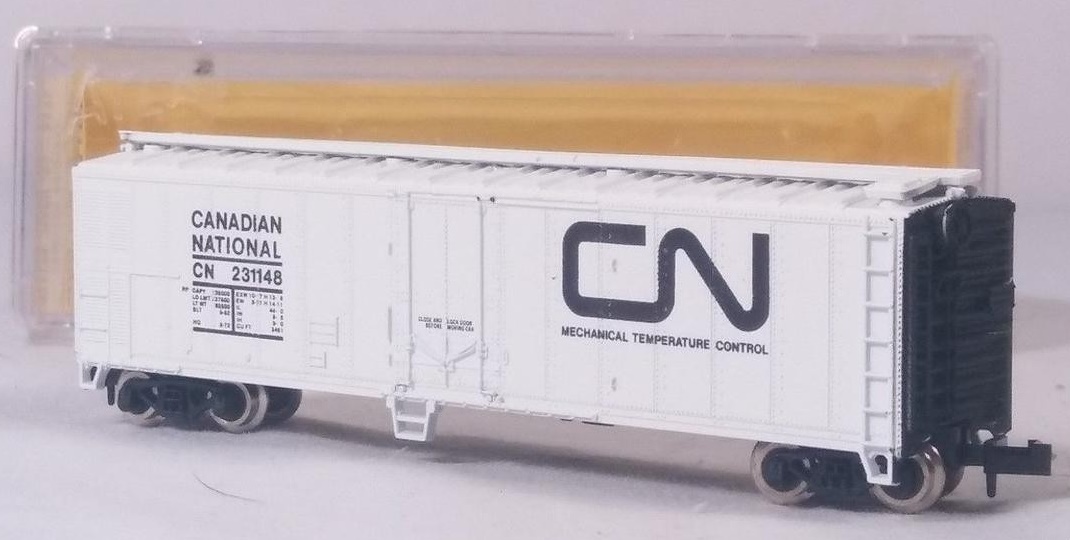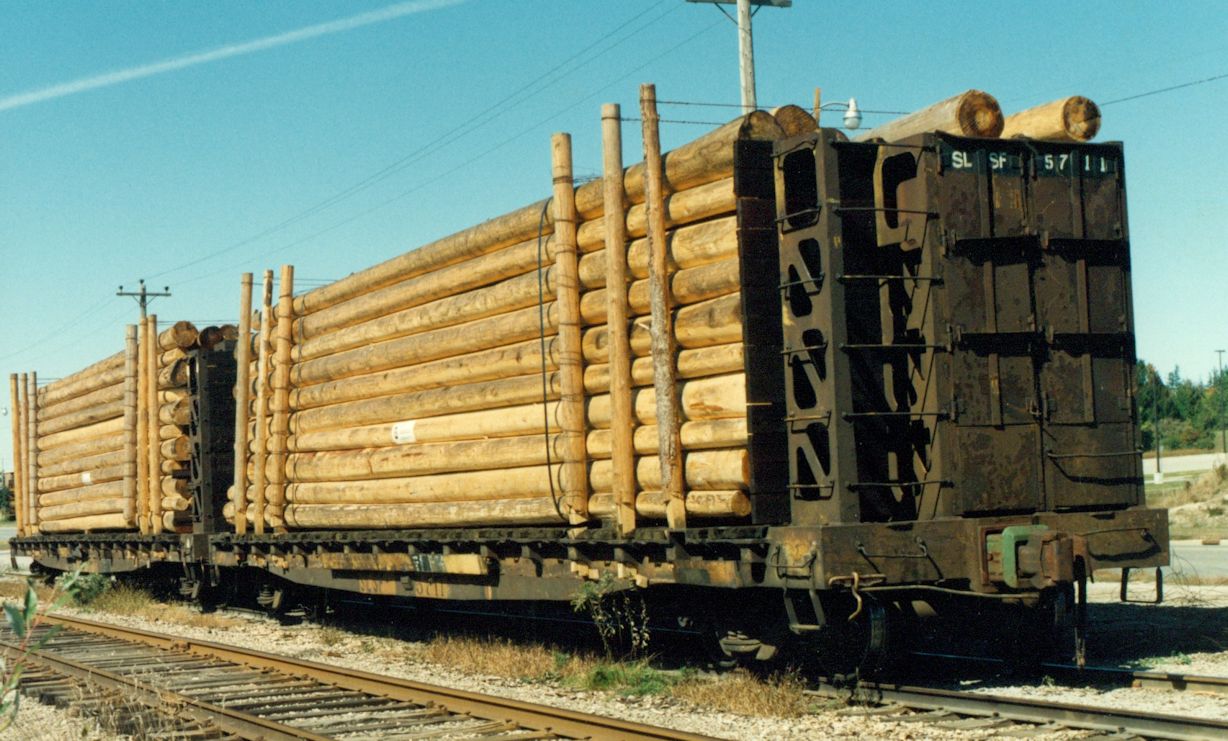Model Information: Model introduced in the mid-1990s, and re-run, with Accumate couplers, in 2007 and 2011.
These models are made of cast metal and include optional bulkheads (as noted) to match prototype practice. So two varieties are available - with and without bulkheads.
In the first run of these cars, three (3) road numbers were offered under the same stock number. In the 2007 run, 3 road numbers were offered as well, but one as a single item and the two others in a 2-pack with a different stock number.
Atlas purchased this tooling from Walthers' N scale range in 2018, and decided to re-run the model in 2019, first in its Bulkhead Flat Car version, as a 48' GSC (General Steel Industries) Bulkhead Flat Car, and then in its bulkhead-less version as 53' 6" flat car. 48-foot represents the interior-length whereas the total length of the car is 53-foot 6-inch, hence Walthers referring to them as 54' GSC flat cars.
One of the most common flat cars in service from the 1950s to the present. These steel cars were considered strong enough to withstand the strain of intermodal service, and their 53' 6"-length was ideal for 32' and 35' trailers. When fitted for piggyback service, the cars were equipped with a hitch and rub rails, numerous tie-downs and bridge plates. In later years, a new hitch replaced the tie-downs.
These models are made of cast metal and include optional bulkheads (as noted) to match prototype practice. So two varieties are available - with and without bulkheads.
In the first run of these cars, three (3) road numbers were offered under the same stock number. In the 2007 run, 3 road numbers were offered as well, but one as a single item and the two others in a 2-pack with a different stock number.
Atlas purchased this tooling from Walthers' N scale range in 2018, and decided to re-run the model in 2019, first in its Bulkhead Flat Car version, as a 48' GSC (General Steel Industries) Bulkhead Flat Car, and then in its bulkhead-less version as 53' 6" flat car. 48-foot represents the interior-length whereas the total length of the car is 53-foot 6-inch, hence Walthers referring to them as 54' GSC flat cars.
One of the most common flat cars in service from the 1950s to the present. These steel cars were considered strong enough to withstand the strain of intermodal service, and their 53' 6"-length was ideal for 32' and 35' trailers. When fitted for piggyback service, the cars were equipped with a hitch and rub rails, numerous tie-downs and bridge plates. In later years, a new hitch replaced the tie-downs.
Prototype History: General Steel Castings (GSC) made the underframes for the Pennsy F30. They decided to create their own product by modifying the Pennsy design. They stretched the design to 53 foot, 6 inches and made the entire body a single casting. The resulting car was manufactured starting in the early 1950s was initially sold as a kit to railroads and only late offered as a complete ready-to-run car. The car was offered in both bulkhead and non-bulkhead versions based on customer requirements.
One of the most common of all flat cars, these rugged designs were in service from the 50s to the 90s and a few still operate today. Built around a large one-piece steel casting, the prototypes could handle a wide range of cargo and were often rebuilt for piggyback loading. These cars are equally at home hauling machinery, steel slabs and more. They were also fitted with bulkheads and handled loads such as lumber and pipe, and a few roads even outfitted them with log bunks for hauling freshly cut timber.
One of the most common of all flat cars, these rugged designs were in service from the 50s to the 90s and a few still operate today. Built around a large one-piece steel casting, the prototypes could handle a wide range of cargo and were often rebuilt for piggyback loading. These cars are equally at home hauling machinery, steel slabs and more. They were also fitted with bulkheads and handled loads such as lumber and pipe, and a few roads even outfitted them with log bunks for hauling freshly cut timber.
Road Name History: The Soo Line Railroad (reporting mark SOO) is the primary United States railroad subsidiary of the Canadian Pacific Railway (CP), controlled through the Soo Line Corporation, and one of seven U.S. Class I railroads. Although it is named for the Minneapolis, St. Paul and Sault Ste. Marie Railroad (MStP&SSM), which was commonly known as the Soo Line after the phonetic spelling of Sault, it was formed in 1961 by the consolidation of that company with two other CP subsidiaries, the Duluth, South Shore and Atlantic Railroad and Wisconsin Central Railroad. It is also the successor to other Class I railroads, including the Minneapolis, Northfield and Southern Railway (acquired 1982) and Chicago, Milwaukee, St. Paul and Pacific Railroad (Milwaukee Road, acquired at bankruptcy in 1985). On the other hand, a large amount of mileage was spun off in 1987 to Wisconsin Central Ltd., now part of the Canadian National Railway.
The Soo Line and the Delaware and Hudson Railway, the CP's other major subsidiary (before the 2008 DM&E acquisition), presently do business as the Canadian Pacific Railway, and most equipment has been repainted into the CP's scheme, but the U.S. Surface Transportation Board groups all CP's U.S. subsidiaries under the Soo Line name for reporting purposes.
The Soo Line and the Delaware and Hudson Railway, the CP's other major subsidiary (before the 2008 DM&E acquisition), presently do business as the Canadian Pacific Railway, and most equipment has been repainted into the CP's scheme, but the U.S. Surface Transportation Board groups all CP's U.S. subsidiaries under the Soo Line name for reporting purposes.
Brand/Importer Information: In 1924 Stephan Schaffan, Sr. founded the Atlas Tool Company in Newark, New Jersey. In 1933 his son, Stephan Schaffan, Jr., came to work for his father at the age of sixteen. Steve Jr. built model airplanes as a hobby and frequented a local hobby shop. Being an enterprising young man, he would often ask the owner if there was anything he could do to earn some extra spending money. Tired of listening to his requests, the hobby-store owner threw some model railroad track parts his way and said, "Here, see if you can improve on this".
In those days, railroad modelers had to assemble and build everything from scratch. Steve Jr. created a "switch kit" which sold so well, that the entire family worked on them in the basement at night, while doing business as usual in the machine shop during the day.
Subsequently, Steve Jr. engineered the stapling of rail to fiber track, along with inventing the first practical rail joiner and pre-assembled turnouts and flexible track. All of these products, and more, helped to popularize model railroading and assisted in the creation of a mass-market hobby. The budding entrepreneur quickly outgrew the limitations of a basement and small garage operation. Realizing they could actually make a living selling track and related products, Steve and his father had the first factory built in Hillside, New Jersey at 413 Florence Avenue in 1947. On September 30, 1949, the Atlas Tool Company was officially incorporated as a New Jersey company.
In 1985, Steve was honored posthumously for his inventions by the Model Railroad Industry Association and was inducted into the Model Railroad Industry Hall of Fame in Baltimore, Maryland. In addition, Steve was nominated and entered into the National Model Railroad Association Pioneers of Model Railroading in 1995.
In the early 1990s, the Atlas Tool Company changed its name to Atlas Model Railroad Company, Inc.
In those days, railroad modelers had to assemble and build everything from scratch. Steve Jr. created a "switch kit" which sold so well, that the entire family worked on them in the basement at night, while doing business as usual in the machine shop during the day.
Subsequently, Steve Jr. engineered the stapling of rail to fiber track, along with inventing the first practical rail joiner and pre-assembled turnouts and flexible track. All of these products, and more, helped to popularize model railroading and assisted in the creation of a mass-market hobby. The budding entrepreneur quickly outgrew the limitations of a basement and small garage operation. Realizing they could actually make a living selling track and related products, Steve and his father had the first factory built in Hillside, New Jersey at 413 Florence Avenue in 1947. On September 30, 1949, the Atlas Tool Company was officially incorporated as a New Jersey company.
In 1985, Steve was honored posthumously for his inventions by the Model Railroad Industry Association and was inducted into the Model Railroad Industry Hall of Fame in Baltimore, Maryland. In addition, Steve was nominated and entered into the National Model Railroad Association Pioneers of Model Railroading in 1995.
In the early 1990s, the Atlas Tool Company changed its name to Atlas Model Railroad Company, Inc.
Manufacturer Information: 'Atlas Model Railroad' represents the New Jersey manufacturing facility for Atlas brand model railroad products. Atlas also imported European made models in their early years and those items will be noted as having manufacturers set appropriately. In the 1990s Atlas moved all their toolings to China.
Item created by: CMK on 2019-10-02 06:09:35. Last edited by CMK on 2020-05-13 18:41:14
If you see errors or missing data in this entry, please feel free to log in and edit it. Anyone with a Gmail account can log in instantly.
If you see errors or missing data in this entry, please feel free to log in and edit it. Anyone with a Gmail account can log in instantly.


